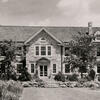In 2001, more than 4,700 traditional and non-traditional students were attending classes at Temple University Ambler and at the Fort Washington Graduate and Professional Center, which opened in 1997 as a result of a renewed burst in enrollment.
Under the direction of Dean Dr. Sophia T. Wisniewska, who began her tenure in 1999, programs central to the Ambler campus — Landscape Architecture, Horticulture, and Community and Regional Planning (established as a program in 2002) were officially recognized as Ambler College, the 17th college of Temple University, in spring 2000 as part of an ongoing effort to enhance the programs and services offered to both students and the surrounding community.
“This new academic structure will help to give us a stronger identity and help to strengthen our relationship with the Main Campus,” said Dr. Wisniewska of the transition to college status. “It's important that we use this new status to develop our strengths, to create our own niche — our own voice — for higher education.”
In March 2000, the campus was officially designated an arboretum by the University Board of Trustees. The Center for Sustainable Communities was established shortly thereafter in July 2000 and awarded a $1.5 million federal grant.
“The Center allows us to expand upon our research and outreach mission, and it will showcase the campus as a scientific resource, a living laboratory for environmental concerns,” Dr. Wisniewska said.
Building upon the unique history of the campus, the Center serves as a local and regional resource that facilitates the development of collaborative solutions in land-use planning and management, environmental protection, ecological restoration, and community revitalization through education and consulting initiatives.
“As part of Temple, I think (Ambler) was noticed and then not noticed. I think now people are sitting up and saying ‘Hey, look at Ambler, maybe we should be taking more notice,’” Frumer said. “I think in particular the grant funding for the Center was a great thing. I think the impact of it, the recognition, was a good thing for Ambler in moving toward the future.”
In 2002, the Temple University Board of Trustees approved bachelor's and master's degrees in Department of Community and Regional Planning. Twenty-five students in the master's degree program have graduated to date.
In September 2002, the Pennsylvania Historical and Museum Commission dedicated an historical marker commemorating the Pennsylvania School of Horticulture for Women at Ambler. The marker is located near the campus entrance on Meetinghouse Road.
On April 22, 2003, Temple University Ambler held its first "EarthFest" event, an outdoor educational celebration of Earth Day hosted by the Center for Sustainable Communities. Temple provides a full day of interactive events and exhibits promoting environmental awareness and the use of sustainable concepts, methods, and practices to protect and preserve our environment. At EarthFest, organizations, businesses, colleges, high schools, middle schools, elementary schools, and individuals demonstrate sustainable concepts and technologies, and provide interactive educational displays, activities, and more.
In Spring 2004, NCAA sports came to campus for the first time. New fields, part of a $4.5 million project, were opened to serve as the full-time home for the Temple University men's soccer, women's soccer, baseball, and softball teams. In September 2004, Ambler broke ground on a new Intercollegiate Athletics Field House, which was officially opened in October 2005. The building includes coaches' offices, equipment rooms, a weight-training facility, locker rooms and storage areas and is comprised of a central hub with two off-shooting "wings" giving it a distinctive owl design.
In November 2004, Temple University Ambler broke ground on a new Learning Center. The Ambler Learning Center is the focal point for state-of-the-art teaching technology and provides new instructional space for use by many academic departments.
The Learning Center, funded predominantly by the Commonwealth of Pennsylvania and designed by BLM Architects of King of Prussia, includes "smart" classrooms, fully integrated technology including wireless access throughout the building, five computer lab/classrooms, a math, science, and writing center, a video editing lab, art studios, a café, and a 300-seat auditorium.
Construction on the 72,000-square-foot Learning Center, located between the Dining Center and the Library Building, began in May 2005.
In September 2005, Dr. James W. Hilty, a nationally recognized professor of history and member of the Temple University faculty since 1970, was appointed acting dean at Temple University Ambler. Coordinator of History at Ambler for many years and first chair of the Ambler Collegial Assembly, Dr. Hilty is overseeing the innovative changes and additions coming to campus with the opening of the Learning Center and the establishment of the School of Environmental Design.
In October 2005, with the help of a $50,000 grant from PECO Energy, Temple University Ambler dedicated and important addition to the Ambler Arboretum, the PECO Green Roof Garden, atop the Intercollegiate Athletics Field House. A green roof is a living biological community of plants and microorganisms that provides an environmentally sound alternative to a traditional roof system.
Continued research involving the green roof garden includes the acquisition, study, and cultivation of new plant material; continued study of the green roof's impact on energy efficiency, water quality, water retention, and roof temperature; development of a green roof course and additional independent study programs; and increased educational outreach programs to promote green roof technology.


